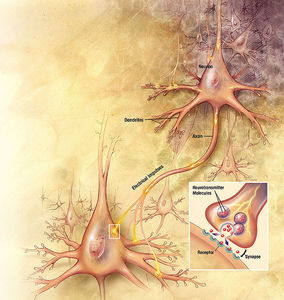Neuron
Structure And Function, Structural Classification, Glial Cells, Functional Classification

Neurons are nerve cells (neurocytes), which, together with neuroglial cells, comprise the nervous tissue making up the nervous system. The neuron is the integral element of our five senses and of countless other physical, regulatory, and mental faculties, including memory and consciousness. A neuron consists of a nerve cell body (or soma), an elongated projection (axon), and short branching fibers (called dendrites). Neurons receive nerve signals (action potentials), integrate action potentials, and transmit these signals to other neurons or effector organs, such as muscles and glands. The structure and function of neurons is essentially the same in all animals, although the human nervous system is much more specialized and complicated than that of lower animals. Humans are born with a large, but finite, supply of neurons and those cells that are lost through aging, injury, or disease cannot be replaced.
The unique morphological and intercellular structure of the neuron is dedicated to the efficient and rapid transmission of neural signals. Within the neuron, the neural signal travels electrically. At the synapse, the gap between neurons, neural signals are conveyed chemically by a limited number of chemicals termed neurotransmitters. Specialized parts of the neuron facilitate the production, release, binding, and uptake of these neurotransmitters.
Additional topics
- Neuron - Structure And Function
- Neuron - Structural Classification
- Neuron - Glial Cells
- Neuron - Functional Classification
- Other Free Encyclopedias
Science EncyclopediaScience & Philosophy: Mysticism to Nicotinamide adenine dinucleotide